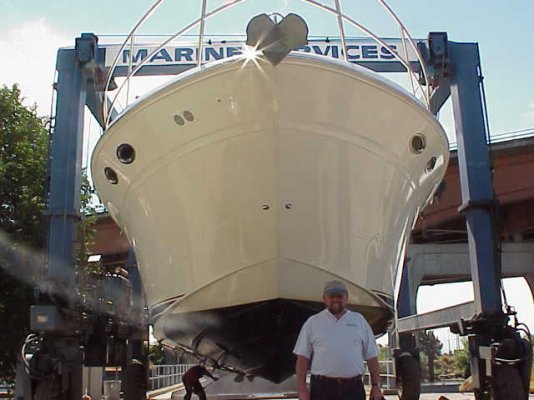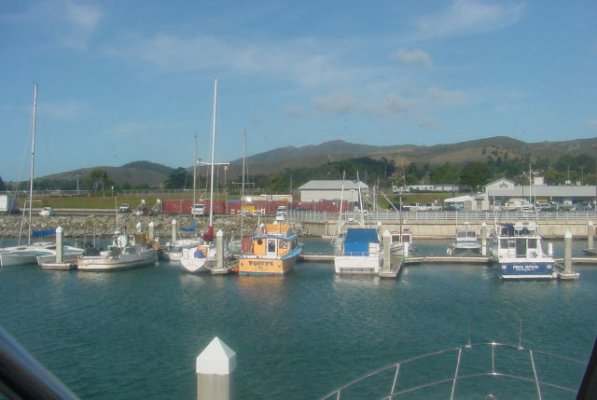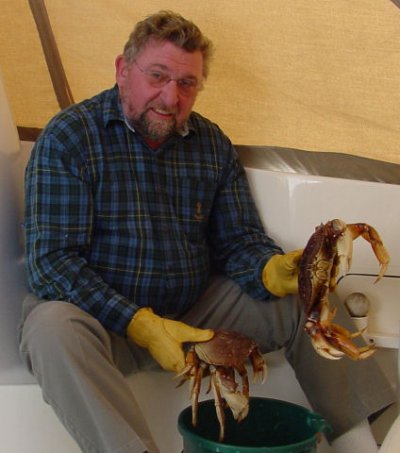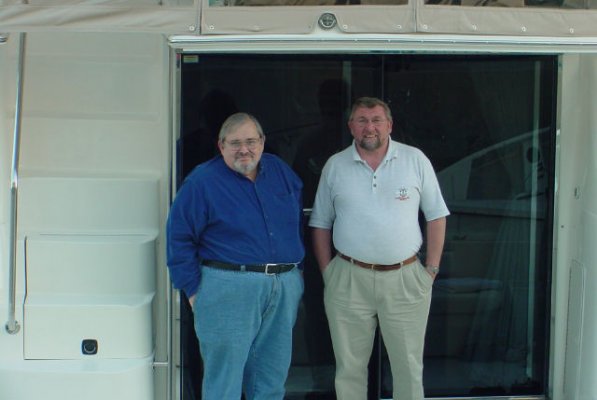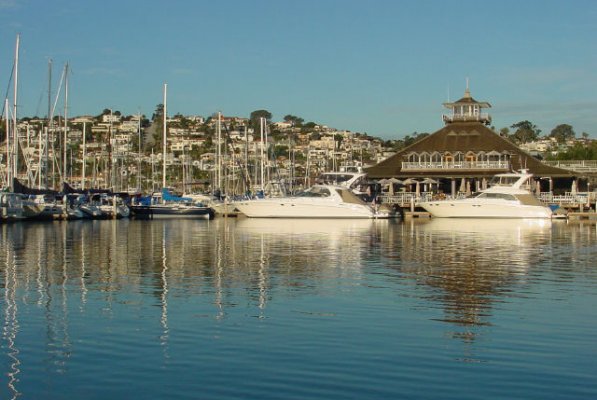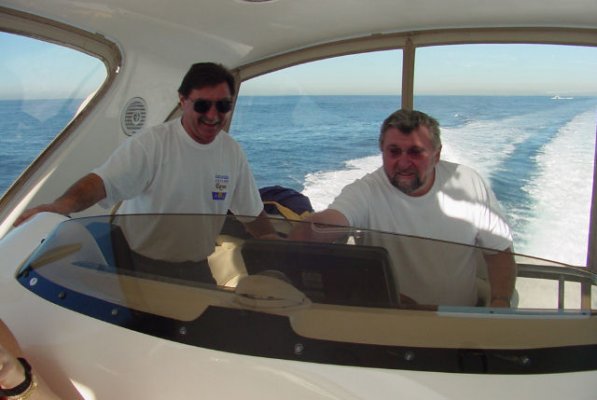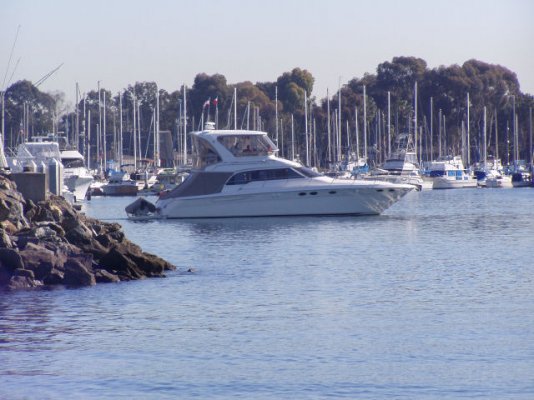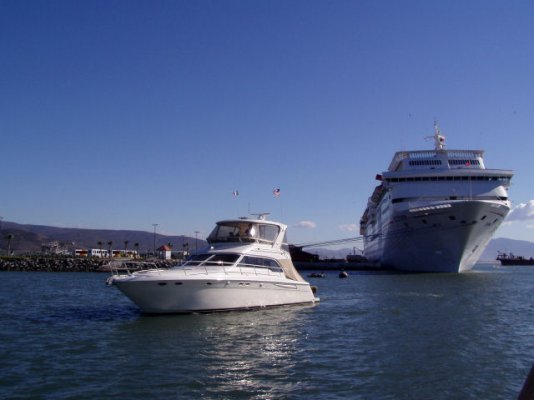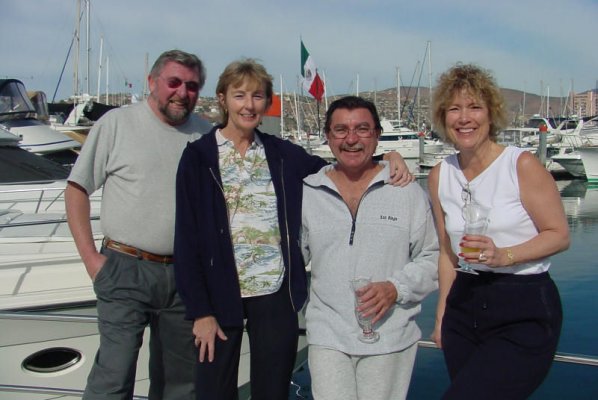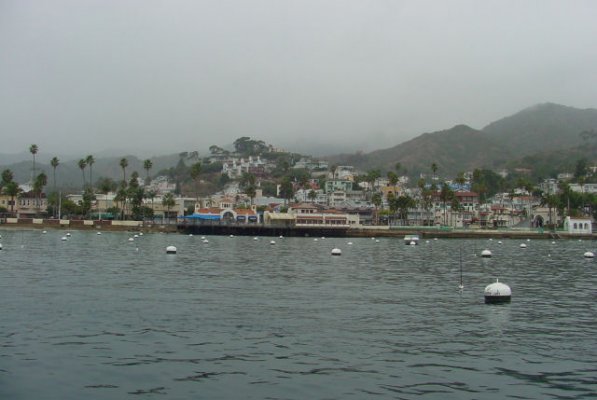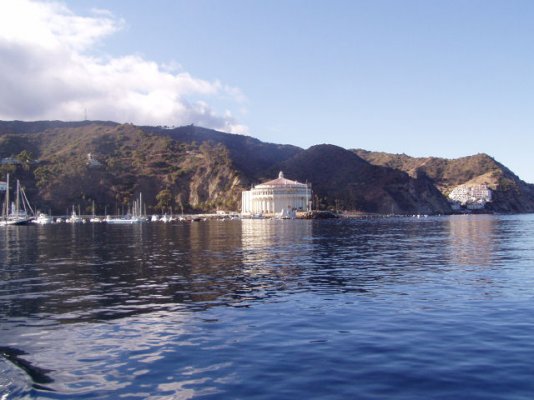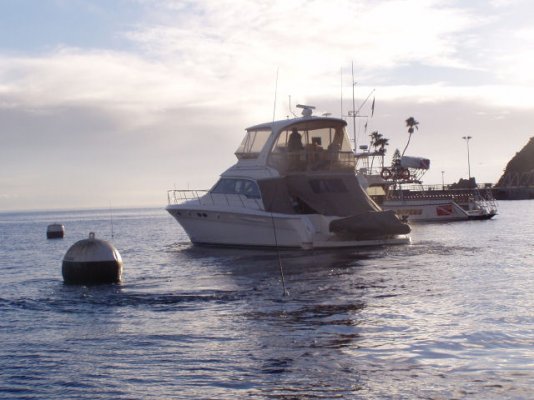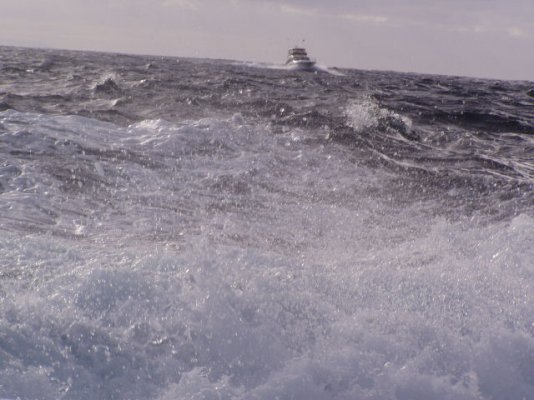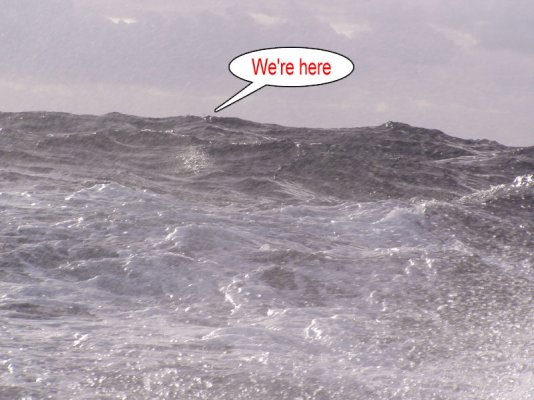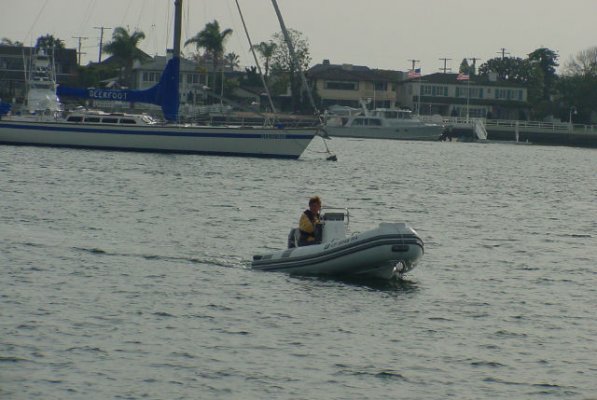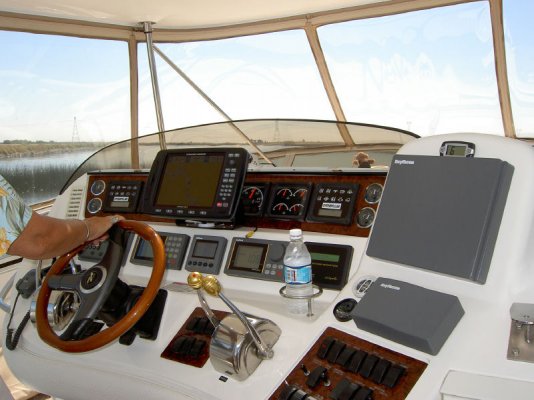Tom
Administrator
- Joined
- Jan 13, 2005
- Posts
- 52,156
Before this gets too far back in my memory, I thought I'd share the experiences of our trip down the Calfiornia coast late in 2003. Our 48 foot Sea Ray Sedan Bridge (51 foot LOA) with twin 660hp Caterpillar engines was up to the task, but we hadn't previously taken the boat further south than Monterey. We planned to hook up with several other boats along the way, one of which had left a month earlier. I'll fill in more detail as it comes to mind &/or I find some of my notes. I'll also add some photos when I get a chance.
We prepared extensively for this trip, but didn't necessarily plan every stop in detail. We prefer not to be on a fixed schedule and tend to go where and when we feel like it. We had only three fixed waypoints - San Diego for Christmas, Ensenada for the new year and home at the end of the trip. Our preparations included:
A few additional things I would have liked to have done before the trip were:
December 8. We cast off lines and made our way down to the Oakland inner harbor. After refuelling, we berthed at the Oakland Yacht Club.
December 9. We left the Oakland Yacht Club around 7.00am on this December day and headed across San Francisco bay. The weather forecast was good for the daylight hours, but things would start to turn ugly late in the evening. We planned to be safely in Monterey harbor, a four hour trip from San Francisco, long before the weather was scheduled to break. We didn't even bother to put on our anti-seasick bands.
As we exited the Golden Gate and entered the infamous Potato Patch, a normally choppy body of water that stretches out for a couple of miles, I commented that things looked a bit choppier than I was expecting, but we motored on. It didn't take too long to realize that the bad weather was already coming in way ahead of forecast and the Captain was too sick to stay at the helm. I took over and decided to head for Pillar Point Harbor at Half Moon Bay, the first port of refuge south of the Golden Gate.
We were soon down to 9 knots and I knew it was going to be a tough U-turn into Pillar Point. The combination of high wind and rough seas coming from the south could easily capsize the boat as we made the turn and there are also some dangerous reefs outside the harbor entrance. I looked over at the LCD monitor for my charts and course from the computer, but the monitor had flipped 90 degrees and was facing up at the hard top of the bridge. Fortunately, I'd installed a 10" fixed chart plotter at the helm before leaving and had all the charts loaded, but not my course data. This was good enough for me to navigate safely into the harbor.
Four hours after exiting the Golden Gate we were tied up safely in the Pillar Point harbor. In good weather, this trip would take only an hour or so. A number of commercial fishing boats followed us into the harbor, all caught by the unexpected early change in the weather. There were 28 foot seas that afternoon and things got worse overnight. The following morning one fisherman with a 60' boat told me he was caught out at the Farallon Islands, 25 miles offshore, and he wasn't sure he'd make it safely into port.
The inclement weather meant we were stuck at Pillar Point for 3 days, which gave me a chance to become acquainted with the local fishermen. Some were very interesting characters with fascinating stories. One fisherman kindly gave us some crabs from his latest catch.
December 12. Conditions had improved enough for us to set out for Monterey where we topped up with fuel and berthed overnight.
December 13. We headed south to Morro Bay. Since this entrance can be quite hazardous, I called the U.S. Coast Guard at Morro Bay and asked about conditions at the entrance. The reply was "Skipper, no problems over the bar and unlimited visibility". When I explained I was outside the entrance in thick fog and couldn't see the bow of our boat, there was a long silence before a request for our GPS coordinates. I read them off the screen and there was another long silence before "Very clear coordinates skipper, let us know if we can help further".
Fortunately, I'd previously been into this harbor on several other boats, but it was still a little tricky getting through the S-shaped channel unable to see the channel markers. When we were safely inside the harbor I realized why the USCG had reported "unlimited visibility" - the fog ended abruptly like a wall and there was a beautiful clear sky over the harbor.
We refuelled at the fuel pier and, after a short wait at the city dock, we tied up at the Morro Bay Yacht Club. We were later joined by two other boats that had left San Francisco Bay that morning. That evening several club members told us we weren't going anywhere for several days, thanks to the weather. They also pointed out a number of photos in the clubhouse that showed various boats capsized at the entrance to the harbor. One famous one was George C. Scott's 110' boat that was left vertical (bow down, stern facing the sky) at the entrance.
December 14. We awoke to find ourselves pinned to the dock by the fierce southerly wind and figured the locals were right - we were going to be stuck here. However, after an hour or so the wind turned around to the north long enough for us to be able to safely head out of the harbor.
Approximately 9 hours later, as we rounded Point Dume and started to cross Santa Monica Bay, I said "20 minutes and we'll be safely tied up in the harbor". No sooner had I said that than, for the first time, both fuel gauges read the same and both registered near empty. Gulp! All my mental calculations said that we had plenty of fuel and the two other similarly sized boats with similar engines both reported plenty of remaining fuel. But, when my captain mentioned "the fuel gauges didn't read quite full when you fuelled back at Morro Bay", it was enough to put doubt into my mind.
We throttled back to 9 knots to conserve fuel and idled into Marina Del Rey. My "20 minutes" became 2 hours and I was really glad to finally get to the fuel dock. After refuelling, my recalculations said that we had 153 gallons spare! We tied up at the Del Rey Yacht Club and put it down to experience.
This was a nice club in a nice, but large, marina with plenty of marine-related services. I took the opportunity to replace two 8D lead acid batteries that provide 24V for the bow thruster with a pair of AGM batteries. We also got to meet forum staffer Carl Lundquist and his wife Cindy. They kindly picked us up by car, gave us a tour of the local area and drove us to their home. Carl demonstrated his BBQing skills before showing me his huge collection of music CDs.
December 20. Two boats headed to San Diego while we and another boat headed to Santa Catalina Island. We pulled into Avalon harbor and picked up an assigned mooring. The choices for getting to shore are either by dinghy or catch a water taxi. This is a neat place for an overnight stop, but beware of the "LA crowds" coming in on weekends. Also check the weather - when the Santa Ana winds pick up, they empty the harbor. Virtually as soon as we were hooked to the mooring, the harbor patrol boarded the boat and popped a couple of dye tablets down the heads and flushed. If anyone is dumb enough to pump their head overboard while in harbor, the orange colored die would be a dead giveaway and they'd be escorted out to sea.
December 21. After a night on the mooring, we continued south. Berthing in San Diego Bay is expensive ($3/foot/night), so we opted to berth at the Hyatt Islandia Hotel in nearby Mission Bay. The harbormaster turned out to be of Welsh extraction and kindly shared his "Welsh Cakes" with me. (His wife makes them from a family recipe and packs them with his lunch every day). In return I taught him a few Welsh sayings which he would repeat to his Welsh-speaking brother in Florida during their evening phone conversations.
Since we were going to be here a week, we rented a car. A couple of days in Mission Bay and it was Christmas eve. Our daughter, son-in-law and grandson flew down from Sacramento to spend the holiday with us. Marine World was just across the highway and a necessary place to visit. When the family left a few days later, several other folks drove or flew in to join us for the next leg of the trip.
December 31. Time to head south of the border. Berthing in Ensenada was extremely scarce and we weren't guaranteed a berth until we turned up at the marina. Two of the boats found berths at Marina Corral and we, along with a fourth boat, headed to the CruisePort marina. We toodled around outside the harbor office until they eventually found a couple of berths that were empty for a few nights. This was new year's eve!
CruisePort is only a short walk from town. If you can negotiate the numerous local peddlers who anxiously await folks disembarking the cruise ships, it's a fun walk. Alternatively, taxis are readily available and reasonably priced.
January 3. It was time to head back to San Diego. When we exited the CruisePort harbor it was a bit of an uncomfortable ride. The Captain had graciously given her anti-seasick band to one of our guests and the rough seas soon took their toll. First stop at San Diego has to be the U.S. Customs dock. We'd called ahead and customs officers were waiting for our arrival. Two of them boarded our vessel and one boarded the other boat. I heard one of them say "I want to do Tom Jones' boat" and I said something like "well, you'll be disappointed". Soon afterwards is when I realized I'd mislaid our passports that I'd tucked away in "a safe place" a couple of months earlier. But, thanks to a helpful customs officer and a call to their office at the airport, we were soon on our way; I'd travelled internationally so many times over the years that I was "in the computer".
After clearing customs and refuelling, we berthed at the San Diego Yacht Club for several days before proceeding our harbor hop up the coast.
January 7. Newport Bay was a good place to hang out for several days. This is a large protected bay with numerous waterfront homes. The Balboa Yacht Club was accomodating and allowed us to tie up at their guest dock.
January 10. Time to move on. After fuelling at Alamitos Bay, we tied up at an assigned berth at the city dock. Public transport to nearby Long Beach and attractions such as the Queen Mary were pretty good. While at this stop, I decided to replace our Avon RIB (hard bottom) dinghy and aging Mercury 2-cycle outboard engine with a center console Caribe and 40hp 4-cycle Yamaha engine.
January 12. Back in Marina Del Rey for a week, we berthed for a couple of nights at the Del Rey Yacht Club and the remainder of the time at the California Yacht Club directly across the harbor.
January 19. Next stop was Channel Islands/Ventura Marina, a relatively narrow harbor. We'd called ahead and, although the yacht club was going to be closed, they readily told us we could tie up at their guest dock for a couple of nights. This was also a fuelling stop.
January 21. Back to Morro Bay for another fuel stop and an overnight tie up at the yacht club before again heading north.
January 22. We thought about stopping at Monterey for fuel but, since this was a little out of our way and often means waiting in line with the fishing boats, we decided to head to Santa Cruz. They were out of fuel, but the fuel truck was due to arrive in the evening and the fuel dock supposedly opened at 7.00am.
January 23. The fuel dock didn't open until 8.30am and the fuel delivery hadn't arrived. So we headed for San Francisco.
Just south of Half Moon Bay we lost power on the starboard engine and idled into the harbor on the port engine. We were here 3 months earlier on our trek south! After refuelling and changing fuel filters on the starboard engine, we again headed for San Francisco Bay. Once inside the Bay, we headed north and stayed overnight at the Benicia marina.
January 24. First thing in the morning we headed up river and were looking forward to getting home. Once in the Delta, the water was very muddy, thanks to the heavy rains they'd had upstream, but it was as smooth as glass. 30 minutes from home there was a loud 'bump' - we'd hit a submerged log and bent a blade on one of the props, as evidenced by vibration. We slowed to a crawl and were now really looking forward to getting home. 20 minutes to go and the port engine lost power. Down to idle and one engine for the rest of the way.
We finally tied up at the house, closed up the boat and figured we'd take care of everything in the morning after a good night's sleep.
When morning came, I opened the hatch to the engine room and was shocked to see every square inch below decks, including the normally white engines and transmissions, covered in a thick, black, oily soot. I later came to find out that the turbos on both engines had broken studs, allowing exhaust to bypass the turbos and enter the engine room. This clogged both air filters and, since the engines kept sucking, both filters collapsed. The dirty "recycled" exhaust that made it past the filters had backed up at the aftercoolers. I was sure glad this hadn't happened while we were offshore.
We prepared extensively for this trip, but didn't necessarily plan every stop in detail. We prefer not to be on a fixed schedule and tend to go where and when we feel like it. We had only three fixed waypoints - San Diego for Christmas, Ensenada for the new year and home at the end of the trip. Our preparations included:
- Full service on the engines and generator.
- New bottom paint and zincs.
- Re-check every hose and through-hull fitting.
- Spare props with new, secure mounts below decks.
- A supply of spare parts.
- Additional large fenders for harbors with a large surge.
- Additional straps to secure the dinghy.
- Upgraded our life vests to the best offshore style I could find.
- Paper charts and two different types of electronic charts.
- Installing redundant equipment, including a second fixed VHF radio and antenna, a 10" fixed color GPS chartplotter and additional (third) GPS receiver.
- Provided alternative ways for some of the electronics to communicate with each other.
- Two notebook PCs with electronic charts.
- Reading everything I could find on every harbor entrance down the coast, irrespective whether we planned to visit. Charlie's Charts of the Pacific Coast proved to be invaluable.
- Plotted and saved routes for almost every harbor entrance, again irrespective whether we planned to enter.
- Called our insurance carrier to extend coverage for our cruising area.
- Bought the obligatory Mexican flag.
A few additional things I would have liked to have done before the trip were:
- Install a second radar. But, given the $10,000 price tag and some issues with installation/location, I opted to not do this. In retropsect, I could have bought a small, lower priced radar for backup purposes.
- I was really uncomfortable leaving without an EPIRB (emergency radio beacon location transmitter). I subsequently purchased one while we were in San Diego.
December 8. We cast off lines and made our way down to the Oakland inner harbor. After refuelling, we berthed at the Oakland Yacht Club.
December 9. We left the Oakland Yacht Club around 7.00am on this December day and headed across San Francisco bay. The weather forecast was good for the daylight hours, but things would start to turn ugly late in the evening. We planned to be safely in Monterey harbor, a four hour trip from San Francisco, long before the weather was scheduled to break. We didn't even bother to put on our anti-seasick bands.
As we exited the Golden Gate and entered the infamous Potato Patch, a normally choppy body of water that stretches out for a couple of miles, I commented that things looked a bit choppier than I was expecting, but we motored on. It didn't take too long to realize that the bad weather was already coming in way ahead of forecast and the Captain was too sick to stay at the helm. I took over and decided to head for Pillar Point Harbor at Half Moon Bay, the first port of refuge south of the Golden Gate.
We were soon down to 9 knots and I knew it was going to be a tough U-turn into Pillar Point. The combination of high wind and rough seas coming from the south could easily capsize the boat as we made the turn and there are also some dangerous reefs outside the harbor entrance. I looked over at the LCD monitor for my charts and course from the computer, but the monitor had flipped 90 degrees and was facing up at the hard top of the bridge. Fortunately, I'd installed a 10" fixed chart plotter at the helm before leaving and had all the charts loaded, but not my course data. This was good enough for me to navigate safely into the harbor.
Four hours after exiting the Golden Gate we were tied up safely in the Pillar Point harbor. In good weather, this trip would take only an hour or so. A number of commercial fishing boats followed us into the harbor, all caught by the unexpected early change in the weather. There were 28 foot seas that afternoon and things got worse overnight. The following morning one fisherman with a 60' boat told me he was caught out at the Farallon Islands, 25 miles offshore, and he wasn't sure he'd make it safely into port.
The inclement weather meant we were stuck at Pillar Point for 3 days, which gave me a chance to become acquainted with the local fishermen. Some were very interesting characters with fascinating stories. One fisherman kindly gave us some crabs from his latest catch.
December 12. Conditions had improved enough for us to set out for Monterey where we topped up with fuel and berthed overnight.
December 13. We headed south to Morro Bay. Since this entrance can be quite hazardous, I called the U.S. Coast Guard at Morro Bay and asked about conditions at the entrance. The reply was "Skipper, no problems over the bar and unlimited visibility". When I explained I was outside the entrance in thick fog and couldn't see the bow of our boat, there was a long silence before a request for our GPS coordinates. I read them off the screen and there was another long silence before "Very clear coordinates skipper, let us know if we can help further".
Fortunately, I'd previously been into this harbor on several other boats, but it was still a little tricky getting through the S-shaped channel unable to see the channel markers. When we were safely inside the harbor I realized why the USCG had reported "unlimited visibility" - the fog ended abruptly like a wall and there was a beautiful clear sky over the harbor.
We refuelled at the fuel pier and, after a short wait at the city dock, we tied up at the Morro Bay Yacht Club. We were later joined by two other boats that had left San Francisco Bay that morning. That evening several club members told us we weren't going anywhere for several days, thanks to the weather. They also pointed out a number of photos in the clubhouse that showed various boats capsized at the entrance to the harbor. One famous one was George C. Scott's 110' boat that was left vertical (bow down, stern facing the sky) at the entrance.
December 14. We awoke to find ourselves pinned to the dock by the fierce southerly wind and figured the locals were right - we were going to be stuck here. However, after an hour or so the wind turned around to the north long enough for us to be able to safely head out of the harbor.
Approximately 9 hours later, as we rounded Point Dume and started to cross Santa Monica Bay, I said "20 minutes and we'll be safely tied up in the harbor". No sooner had I said that than, for the first time, both fuel gauges read the same and both registered near empty. Gulp! All my mental calculations said that we had plenty of fuel and the two other similarly sized boats with similar engines both reported plenty of remaining fuel. But, when my captain mentioned "the fuel gauges didn't read quite full when you fuelled back at Morro Bay", it was enough to put doubt into my mind.
We throttled back to 9 knots to conserve fuel and idled into Marina Del Rey. My "20 minutes" became 2 hours and I was really glad to finally get to the fuel dock. After refuelling, my recalculations said that we had 153 gallons spare! We tied up at the Del Rey Yacht Club and put it down to experience.
This was a nice club in a nice, but large, marina with plenty of marine-related services. I took the opportunity to replace two 8D lead acid batteries that provide 24V for the bow thruster with a pair of AGM batteries. We also got to meet forum staffer Carl Lundquist and his wife Cindy. They kindly picked us up by car, gave us a tour of the local area and drove us to their home. Carl demonstrated his BBQing skills before showing me his huge collection of music CDs.
December 20. Two boats headed to San Diego while we and another boat headed to Santa Catalina Island. We pulled into Avalon harbor and picked up an assigned mooring. The choices for getting to shore are either by dinghy or catch a water taxi. This is a neat place for an overnight stop, but beware of the "LA crowds" coming in on weekends. Also check the weather - when the Santa Ana winds pick up, they empty the harbor. Virtually as soon as we were hooked to the mooring, the harbor patrol boarded the boat and popped a couple of dye tablets down the heads and flushed. If anyone is dumb enough to pump their head overboard while in harbor, the orange colored die would be a dead giveaway and they'd be escorted out to sea.
December 21. After a night on the mooring, we continued south. Berthing in San Diego Bay is expensive ($3/foot/night), so we opted to berth at the Hyatt Islandia Hotel in nearby Mission Bay. The harbormaster turned out to be of Welsh extraction and kindly shared his "Welsh Cakes" with me. (His wife makes them from a family recipe and packs them with his lunch every day). In return I taught him a few Welsh sayings which he would repeat to his Welsh-speaking brother in Florida during their evening phone conversations.
Since we were going to be here a week, we rented a car. A couple of days in Mission Bay and it was Christmas eve. Our daughter, son-in-law and grandson flew down from Sacramento to spend the holiday with us. Marine World was just across the highway and a necessary place to visit. When the family left a few days later, several other folks drove or flew in to join us for the next leg of the trip.
December 31. Time to head south of the border. Berthing in Ensenada was extremely scarce and we weren't guaranteed a berth until we turned up at the marina. Two of the boats found berths at Marina Corral and we, along with a fourth boat, headed to the CruisePort marina. We toodled around outside the harbor office until they eventually found a couple of berths that were empty for a few nights. This was new year's eve!
CruisePort is only a short walk from town. If you can negotiate the numerous local peddlers who anxiously await folks disembarking the cruise ships, it's a fun walk. Alternatively, taxis are readily available and reasonably priced.
January 3. It was time to head back to San Diego. When we exited the CruisePort harbor it was a bit of an uncomfortable ride. The Captain had graciously given her anti-seasick band to one of our guests and the rough seas soon took their toll. First stop at San Diego has to be the U.S. Customs dock. We'd called ahead and customs officers were waiting for our arrival. Two of them boarded our vessel and one boarded the other boat. I heard one of them say "I want to do Tom Jones' boat" and I said something like "well, you'll be disappointed". Soon afterwards is when I realized I'd mislaid our passports that I'd tucked away in "a safe place" a couple of months earlier. But, thanks to a helpful customs officer and a call to their office at the airport, we were soon on our way; I'd travelled internationally so many times over the years that I was "in the computer".
After clearing customs and refuelling, we berthed at the San Diego Yacht Club for several days before proceeding our harbor hop up the coast.
January 7. Newport Bay was a good place to hang out for several days. This is a large protected bay with numerous waterfront homes. The Balboa Yacht Club was accomodating and allowed us to tie up at their guest dock.
January 10. Time to move on. After fuelling at Alamitos Bay, we tied up at an assigned berth at the city dock. Public transport to nearby Long Beach and attractions such as the Queen Mary were pretty good. While at this stop, I decided to replace our Avon RIB (hard bottom) dinghy and aging Mercury 2-cycle outboard engine with a center console Caribe and 40hp 4-cycle Yamaha engine.
January 12. Back in Marina Del Rey for a week, we berthed for a couple of nights at the Del Rey Yacht Club and the remainder of the time at the California Yacht Club directly across the harbor.
January 19. Next stop was Channel Islands/Ventura Marina, a relatively narrow harbor. We'd called ahead and, although the yacht club was going to be closed, they readily told us we could tie up at their guest dock for a couple of nights. This was also a fuelling stop.
January 21. Back to Morro Bay for another fuel stop and an overnight tie up at the yacht club before again heading north.
January 22. We thought about stopping at Monterey for fuel but, since this was a little out of our way and often means waiting in line with the fishing boats, we decided to head to Santa Cruz. They were out of fuel, but the fuel truck was due to arrive in the evening and the fuel dock supposedly opened at 7.00am.
January 23. The fuel dock didn't open until 8.30am and the fuel delivery hadn't arrived. So we headed for San Francisco.
Just south of Half Moon Bay we lost power on the starboard engine and idled into the harbor on the port engine. We were here 3 months earlier on our trek south! After refuelling and changing fuel filters on the starboard engine, we again headed for San Francisco Bay. Once inside the Bay, we headed north and stayed overnight at the Benicia marina.
January 24. First thing in the morning we headed up river and were looking forward to getting home. Once in the Delta, the water was very muddy, thanks to the heavy rains they'd had upstream, but it was as smooth as glass. 30 minutes from home there was a loud 'bump' - we'd hit a submerged log and bent a blade on one of the props, as evidenced by vibration. We slowed to a crawl and were now really looking forward to getting home. 20 minutes to go and the port engine lost power. Down to idle and one engine for the rest of the way.
We finally tied up at the house, closed up the boat and figured we'd take care of everything in the morning after a good night's sleep.
When morning came, I opened the hatch to the engine room and was shocked to see every square inch below decks, including the normally white engines and transmissions, covered in a thick, black, oily soot. I later came to find out that the turbos on both engines had broken studs, allowing exhaust to bypass the turbos and enter the engine room. This clogged both air filters and, since the engines kept sucking, both filters collapsed. The dirty "recycled" exhaust that made it past the filters had backed up at the aftercoolers. I was sure glad this hadn't happened while we were offshore.


